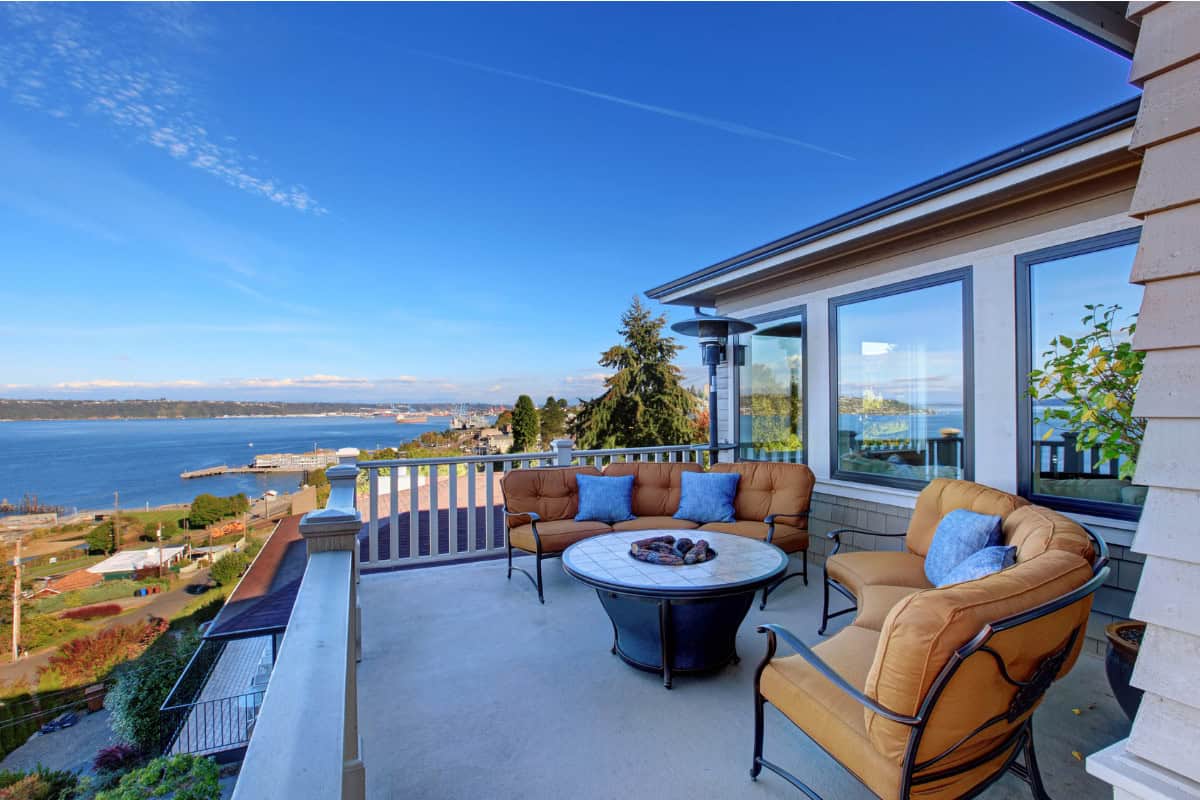
Picture this: You’re enjoying a fire pit on a balcony, wrapped in a nice blanket and sipping hot cocoa or the adult drink of your choice.
Sounds nice, right?
Well, you’re not alone. Searches for balcony fire pits have skyrocketed by 150% in the past year.
But hang on a second. Is it actually okay to have a fire pit on your balcony?
Using a fire pit on a balcony is complex and often restricted. Safety concerns, legal regulations, and building rules typically limit or prohibit open flames in these spaces. While some balcony-friendly alternatives exist, like electric or gel fuel options, it’s crucial to check local laws and obtain proper permissions before considering any fire pit on a balcony.
It’s a hot topic for apartment dwellers, condo owners, and homeowners with balconies.
Let’s cut through the smoke and get to the facts you need to know.
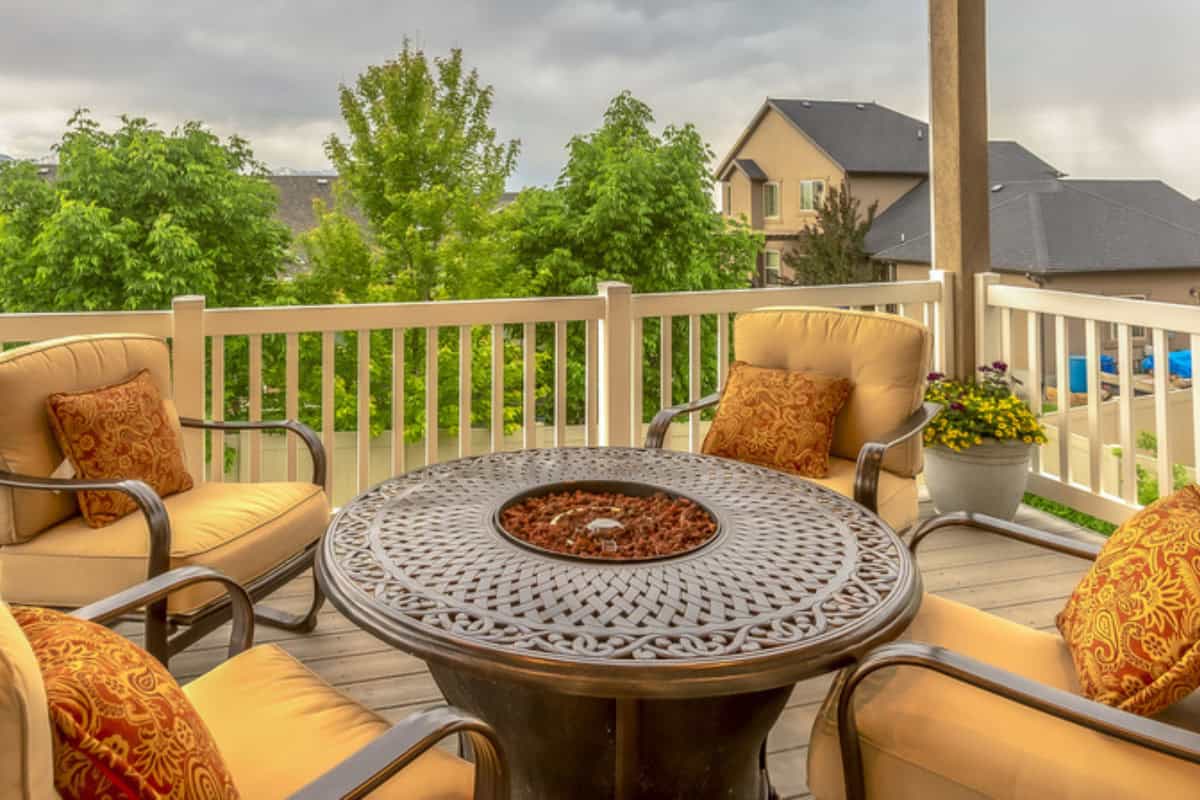
I. Safety First: Considerations for Balcony Fire Pits
Before you start shopping for that perfect fire pit, let’s talk safety. Your balcony might not be as fire-pit-ready as you think.
A. Assessing your balcony’s fire pit readiness
- Space requirements: Fire pits demand ample breathing room for safety. You’ll need at least 3 feet of clearance on all sides, including overhead. Don’t forget to look up – any overhanging structures, eaves, or balconies above need even more clearance, typically 6 to 10 feet. Carefully measure your balcony’s width, depth, and height. Be honest with yourself – is there truly enough space in all dimensions? Remember, a cramped fire pit isn’t just uncomfortable; it’s a serious safety hazard. Your balcony should comfortably accommodate the fire pit, clearance zones, and still allow for easy movement.
- Ventilation concerns: Proper airflow is crucial when using a fire pit on a balcony. Smoke and fumes need a clear path to dissipate safely. You need open air on at least two sides to ensure adequate ventilation. Remember, even on open balconies, wind patterns can affect smoke dispersion, so always be mindful of your surroundings and neighbors.
B. Fire hazards unique to balconies
Balconies pose unique fire risks. They’re often made of flammable or easily damaged materials like wood or composites. Nearby curtains or awnings can catch fire easily.
C. Importance of fire safety equipment
If you’re serious about a balcony fire pit, invest in safety gear. A fire extinguisher is a must.
Also, consider a fire-resistant mat to protect your balcony floor.

II. Legal Landscape: Can You Have a Fire Pit on Your Balcony?
Now for the legal stuff. Just because you want a fire pit doesn’t mean it’s allowed.
A. Local fire codes and regulations
Local fire codes and regulations play a crucial role in determining whether you can have a fire pit on a balcony.
These rules vary significantly depending on your location, so it’s essential to research thoroughly.
Here’s what you need to know:
City ordinances: Many urban areas have specific fire pit codes addressing open flames on balconies. Some cities outright ban fire pits on any elevated structure, while others have strict guidelines.
Fuel type restrictions: Even if fire pits are allowed, there may be limitations on fuel types. For example:
- Wood-burning pits are often prohibited due to smoke and spark concerns.
- Propane or natural gas may be permitted with proper safety features.
Size and output limitations: Codes may specify maximum BTU outputs or physical dimensions for balcony fire pits.
Clearance requirements: Regulations typically mandate minimum distances from walls, ceilings, and combustible materials. These can be more stringent for balconies than ground-level patios.
Permit requirements: Some jurisdictions require permits for balcony fire pits. This often involves an inspection to ensure compliance with safety standards.
Building-specific rules: In multi-unit buildings, fire codes may give property managers or HOAs the authority to impose stricter rules than city regulations.
Fire suppression requirements: You may be required to have a fire extinguisher or other suppression methods readily available.
Usage restrictions: Some areas have rules about when fire pits can be used, such as prohibiting use during high wind conditions or dry seasons.
Penalties: Violating fire codes can result in hefty fines, legal action, or eviction in rental properties.
To ensure compliance:
- Contact your local fire department or city planning office for current regulations.
- Consult your building management or HOA for any additional rules.
- Get all permissions and requirements in writing before purchasing or using a fire pit.
- Stay informed about any changes to local fire codes, as they can be updated periodically.
Remember, these regulations exist for good reasons – to protect you, your neighbors, and your property.
Always prioritize safety and compliance over the desire for a balcony fire pit.g.
B. Building and HOA rules
Your building or HOA might have its own rules regarding fire pits on balconies.
These regulations often supersede local ordinances, meaning they can be more restrictive than city codes.
It’s crucial to read your lease or HOA agreement carefully, paying close attention to any clauses about outdoor appliances or open flames.
Don’t assume that just because the city allows balcony fire pits, your building does too.
When in doubt, always ask for written permission from your property manager or HOA board.
This written approval can protect you from potential disputes or penalties down the line.
Some buildings may require additional safety measures, like specific fire pit models or extra insurance coverage.
Always document any conversations or agreements about balcony fire pit usage to ensure you’re fully compliant with all applicable rules.
Keep in mind that the Community Association Underwriters of America (CAU) recommends that HOA committees prohibit fire pits on balconies. That said, don’t let that stop you from checking into it for your own property.
During my research for this post, I found that many municipalities (at least in the U.S.) are taking their cue from the International Fire Code, or IFC when it comes to an open flame (i.e. fire pits, chimineas, bbq grills, etc.) on residential balconies. Per the IFC site, “the IFC is in use or adopted in 42 states, the District of Columbia, Guam, Puerto Rico, and the U.S. Virgin Islands.”
The basics from the IFC regarding fire pits on balconies:
No using fire pits, grills, open flames, etc. on balconies within 10 feet of a combustible structure, unless…
- the balcony is attached to a one (single-family home) or two-family dwelling (like a duplex). Any dwelling larger than two-family, like an apartment building or condo, may be a no-go.
- the balcony is equipped with an automatic sprinkler system
C. Insurance implications
A balcony fire pit could void your insurance policy, leaving you financially vulnerable in case of an accident.
Some insurers explicitly won’t cover damage caused by “outdoor heating devices,” which often includes fire pits.
Others might allow fire pits but significantly raise your premiums to offset the increased risk. It’s crucial to check with your insurance provider before installing a balcony fire pit.
Ask for a written statement detailing their policy on balcony fire pits and any potential impact on your coverage.
If they do allow fire pits, inquire about any specific safety requirements or restrictions you need to follow to maintain your coverage.
Remember, even if your current policy allows for a fire pit, this could change upon renewal, so stay informed about any updates to your insurance terms.
D. Penalties for non-compliance
Breaking fire pit rules isn’t just dangerous – it’s expensive and can have far-reaching consequences.
Fines for violating fire codes or building regulations can run into thousands of dollars, putting a serious dent in your finances.
But the repercussions don’t stop there. You might face eviction from your apartment or condo, leaving you scrambling to find new housing.
Legal action could follow, potentially resulting in a lawsuit that could impact your credit score and future housing prospects.
In extreme cases, if a fire causes damage to neighboring units or common areas, you could be held personally liable for repairs and medical expenses.
The stress and financial burden of these outcomes far outweigh any temporary enjoyment from an unauthorized fire pit.
It’s simply not worth the risk to your safety, finances, and peace of mind.
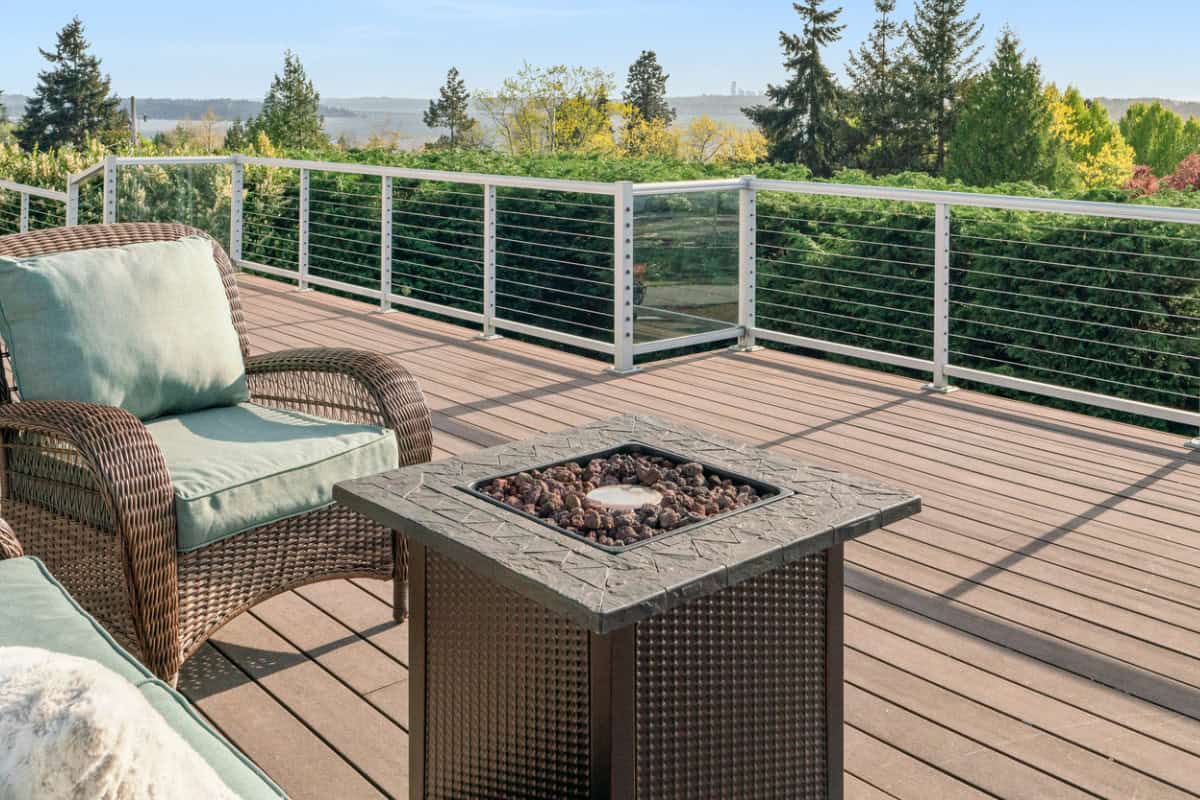
III. Balcony-Friendly Fire Pit Options
Don’t lose hope yet! There are fire pit options designed with balconies in mind.
A. Gel fuel fire pits: Flameless ambiance
Gel fuel fire pits use alcohol-based fuel for a clean burn, offering a compromise between ambiance and safety.
They produce real flames but no smoke or embers, making them a more neighbor-friendly option for close-quarters living.
These are a great middle-ground option for many balconies, especially in areas with stricter fire regulations.
The gel fuel comes in cans or cartridges, which are easy to store and replace, adding to their convenience.
However, it’s important to note that while cleaner than wood-burning pits, gel fuel still produces heat and requires proper ventilation.
Always follow manufacturer guidelines and check local regulations before using a gel fuel fire pit on your balcony.
B. Propane fire pits: Controlled heat for outdoor spaces
Propane fire pits offer real flames with more control than wood, allowing you to adjust the flame height and heat output easily.
They’re often smaller and more portable than traditional pits, making them ideal for balcony spaces where flexibility is key.
Some models are specifically designed for balcony use, with features like compact designs and built-in safety sensors.
These specialized units often have lower BTU outputs to comply with balcony fire codes and may include wind guards to protect the flame.
However, it’s important to consider proper ventilation and gas cylinder storage when using propane on a balcony.
Always ensure you have a safe, outdoor space to store extra propane tanks and follow all manufacturer guidelines for connection and use.
D. Tabletop fire pit: Compact warmth for small balconies
Tabletop wood-burning fire pits, like the Solo Stove Mesa, offer a compact option for those craving a traditional fire experience on their balcony.
These miniature versions of larger fire pits are designed with efficiency and safety in mind, often featuring double-wall construction for improved airflow and reduced smoke.
The small size makes them more manageable in limited spaces and easier to store when not in use.
However, it’s crucial to remember that even these smaller wood-burning options still produce embers and smoke, which may be prohibited on many balconies.
Always check local regulations and building codes before considering a wood-burning option, no matter how small, for balcony use.

IV. Alternatives to Traditional Fire Pits for Balcony Warmth
If fire pits are completely off the table, don’t worry. There are other ways to warm up your balcony.
A. Infrared heaters: Efficient balcony heating
Infrared heaters offer a safe and efficient alternative to fire pits for balcony warmth.
These devices warm people and objects directly, rather than heating the air, making them ideal for outdoor spaces.
They’re incredibly energy-efficient and often allowed on balconies where open flames are prohibited. Look for wall-mounted options to save floor space or freestanding models for flexibility.
Many infrared heaters come with adjustable settings and safety features like tip-over protection and automatic shut-off timers.
When choosing an infrared heater for your balcony, consider the unit’s heating range and ensure its rated for outdoor use.
Remember to keep the heater away from flammable materials and never leave it unattended, even though it doesn’t produce an open flame.
B. Portable electric fireplaces
Portable electric fireplaces offer a safe alternative to traditional fire pits for balcony use.
These units typically feature realistic flame effects created by LED lights, often combined with a built-in electric heater for warmth.
They come in various styles, from sleek modern designs to rustic lantern-like models, allowing you to complement your balcony’s decor.
Most portable electric fireplaces are lightweight, easy to move, and don’t require any special installation or ventilation.
However, it’s crucial to choose a model rated for outdoor use and to protect it from direct exposure to rain or snow when not in use.
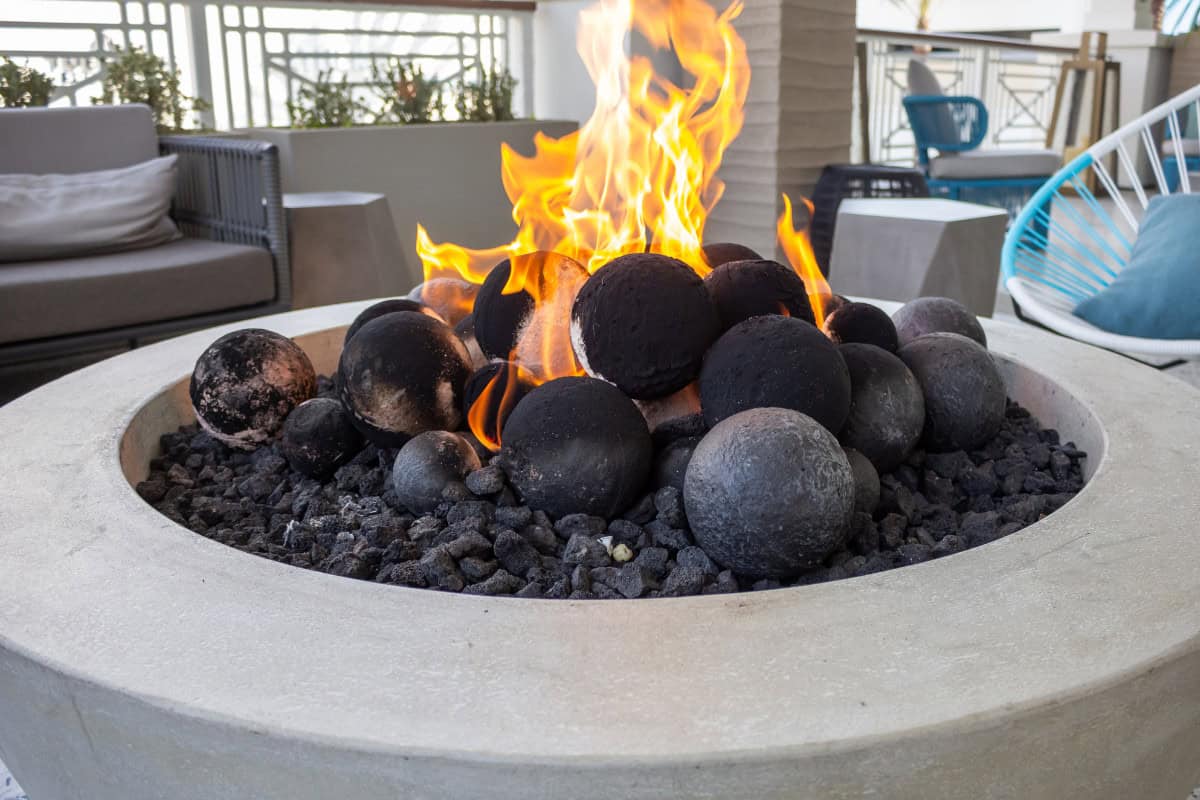
V. Best Practices: Using a Fire Pit on Your Balcony Safely
If you’ve gotten the green light for a balcony fire pit, follow these best practices.
A. Proper placement and clearance
As mentioned earlier in this article, maintaining proper clearance is crucial for balcony fire pit safety.
Keep your fire pit at least 3 feet from all walls and railings to prevent heat damage and reduce fire risks.
This distance also applies vertically – never place a fire pit under overhangs, awnings, or upper balconies.
Ensure the fire pit sits on a stable, non-flammable surface like a fire-resistant mat or concrete pavers.
This not only protects your balcony floor but also provides a level base to prevent tipping.
Remember, these are minimum safety distances – if your balcony space allows, increasing the clearance even further can provide an extra margin of safety.
B. Weather considerations
Wind remains a significant concern when using gas fire pits on balconies.
While they don’t produce embers like wood-burning pits, strong gusts can still affect flame stability and heat distribution.
Avoid using your gas fire pit on particularly windy days to ensure optimal performance and safety.
Keep a close eye on weather forecasts before planning to use your fire pit, and be prepared to turn it off quickly if winds suddenly intensify.
Many gas fire pit models come with built-in wind guards, but these are designed for light breezes, not strong winds.
If your model allows, adjust the flame height lower during slightly windy conditions to maintain better control.
Remember, while gas fire pits are generally safer in wind than their wood-burning counterparts, it’s always best to prioritize safety and avoid use during significantly windy conditions.
C. Supervision and extinguishing procedures
Always supervise your gas fire pit when it’s in use, even though it doesn’t produce embers like wood-burning pits.
Know how to shut off the gas supply quickly in case of an emergency.
While gas fire pits cool down faster than wood-burning ones, still allow the unit to cool completely before covering or storing it.
Familiarize yourself with the manufacturer’s shutdown procedure, which typically involves turning off the gas valve and allowing residual gas in the lines to burn off.
Keep the area around gas connections clear and regularly check for leaks using a soapy water solution.
Remember, even though gas fire pits are generally safer, vigilance is key to preventing accidents.
D. Maintenance and storage tips
Regularly clean your gas fire pit to prevent buildup of dust, debris, or insects that can clog burners or gas lines.
Inspect and clean the burner ports periodically to ensure even flame distribution.
Store propane tanks safely outdoors, away from heat sources and direct sunlight, never inside your home or in enclosed spaces.
When not in use, turn off the gas supply at the tank and cover your fire pit to protect it from the elements.
This helps prevent moisture buildup and corrosion of components. Check gas connections and hoses regularly for signs of wear or damage, replacing them as needed.
Keep the area around your gas fire pit clear of flammable materials and debris to maintain safe operation.

VI. Top Fire Pit Products for Balcony Use
Here are some top picks for balcony-friendly fire pits:
A. Best electric fire pit for apartments: Duraflame 3D Infrared Electric Fireplace Stove
This electric stove offers realistic flames without any actual fire. It’s safe, efficient, and perfect for small apartment balconies.
B. Top propane fire pit for larger balconies: Outland Living Firebowl 893 Deluxe
This portable propane fire pit is specifically designed for outdoor spaces like balconies. It’s easy to use and produces no sparks or embers.
C. Safest gel fuel fire pit for condos: Regal Flame Black Ventless Tabletop Fireplace
This sleek tabletop fireplace uses clean-burning gel fuel. It’s perfect for adding ambiance to condo balconies without the worry of smoke or ash.
D. Most stylish fire pit table for home balconies: Best Choice Products 45in Propane Fire Pit Table
This fire pit table offers both warmth and functionality. It’s a great centerpiece for larger home balconies, with plenty of space for drinks and snacks.

VII. Wrap-up: Using a Fire Pit on a Balcony
So, can you use a fire pit on a balcony? The answer isn’t a simple yes or no. It depends on your local laws, building rules, and balcony setup. Safety should always be your top priority.
For apartment and condo dwellers, electric or gel fuel options are often your safest bet. Homeowners with larger balconies might be able to use propane fire pits, but always check local regulations first.
Remember, a cozy balcony doesn’t require an open flame. Consider alternatives like infrared heaters or electric fireplaces. They can provide warmth and ambiance without the safety concerns.
Before making any decisions, consult your local fire department and property manager. Get any permissions in writing. And always prioritize safety over ambiance.
The benefits of a fire pit on your perfect balcony oasis are within reach. With the right knowledge and precautions, you can create a warm, inviting outdoor space – fire pit or not.
When looking into buying the safest fire pit it’s not uncommon for buyers to take a minute to think about where they’re going to use it and if it’s legal or even smart to do so.
For related content, check out my article, Can I Use a Fire Pit Under a Covered Patio?
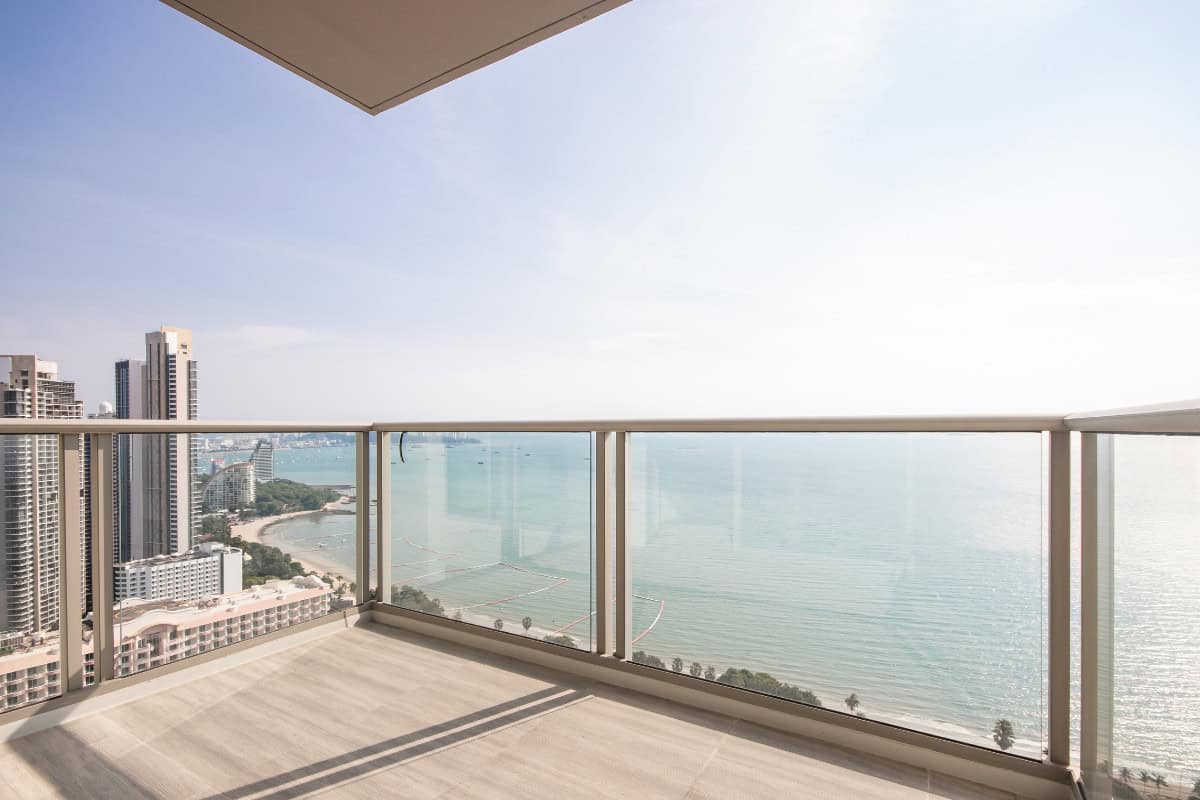
VIII: FAQs: Using a Fire Pit on a Balcony
Having a fire pit on a deck requires careful consideration and precautions. While it can be done safely under certain conditions, it’s not without risks.
The primary concerns are heat damage to the deck surface and potential fire spread.
To safely use a fire pit on a deck, you must ensure proper clearance from flammable structures, use a fire-resistant barrier beneath the pit, and choose an appropriate pit size for your space.
Gas or propane fire pits are generally safer options for decks than wood-burning ones.
Always check local regulations, as some areas prohibit open flames on wooden structures.
Additionally, keep a fire extinguisher nearby and never leave the fire unattended.
Ultimately, while having a fire pit on a deck is possible, many experts recommend placing it on a non-combustible surface like concrete or stone pavers for optimal safety.
Fire safety experts generally consider placing a fire pit on a concrete patio safe and often recommend this practice.
Concrete is non-combustible and provides a stable, level surface for your fire pit.
However, there are still important factors to consider. Ensure adequate clearance from structures, overhanging trees, or other flammable objects.
Fire safety experts often recommend and consider it safe to place a fire pit on a concrete patio.
For wood-burning fire pits, sparks and embers can potentially stain or etch the concrete surface, so consider using a protective mat or pad.
Gas or propane fire pits are less likely to cause damage. Always follow manufacturer guidelines for your specific fire pit model and check local regulations regarding outdoor fires.
While concrete patios are one of the safest locations for a fire pit, proper usage and maintenance are still crucial for ensuring safety and preserving your patio’s condition.
To protect your balcony from a fire pit, several safety measures are essential. First and foremost, use a fire-resistant mat or pad designed specifically for fire pits.
Manufacturers typically make these mats from materials like volcanic rock, fiberglass, or heat-resistant silicone.
They provide crucial protection against heat damage, sparks, and embers.
For added safety, consider placing heat-resistant pavers or tiles underneath the fire pit and mat. This creates an extra barrier between the heat source and your balcony surface.
If your balcony has wooden decking, a metal heat shield can offer additional protection. Always ensure there’s proper ventilation and maintain recommended clearances from walls and railings.
Remember, while these protective measures are important, they don’t guarantee complete fire pit safety.
Always check your local regulations and building codes, as many areas restrict or prohibit fire pits on balconies due to the inherent risks involved.

During my research for this post, I found that many municipalities (at least in the U.S.) are taking their cue from the International Fire Code, or IFC when it comes to an open flame (i.e. fire pits, chimineas, bbq grills, etc.) on residential balconies. Per the IFC site, “the IFC is in use or adopted in 42 states, the District of Columbia, Guam, Puerto Rico, and the U.S. Virgin Islands.”
The basics from the IFC regarding fire pits on balconies:
No using fire pits, grills, open flames, etc. on balconies within 10 feet of a combustible structure, unless:
- the balcony is attached to a one (single-family home) or two-family dwelling (like a duplex). Any dwelling larger than two-family, like an apartment building or condo, may be a no-go.
- the balcony is equipped with an automatic sprinkler system
No LP-gas containers that exceed 1 lb. gas capacity within 10 feet of a combustible structure, unless:
- the balcony is attached to a one (single-family home) or two-family dwelling (duplex, very small apartment building/condo); like the entry above, it may not be permitted in buildings larger than two-family.
To meet a 1 lb. gas capacity requirement a 1 lb. propane bottle is your best bet., It’s basically the same kind you would use to fuel a portable camping stove.

